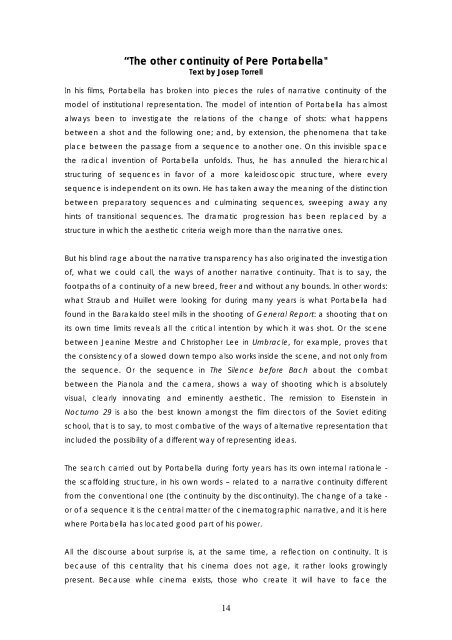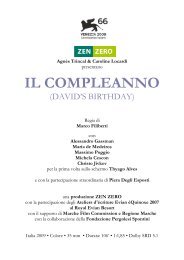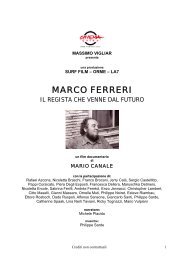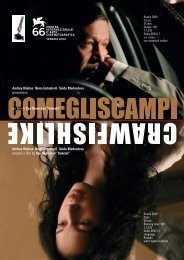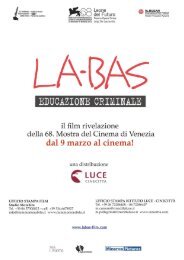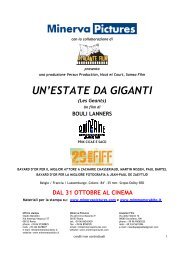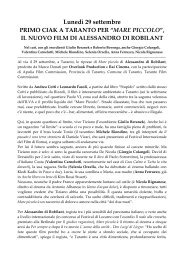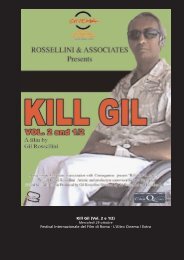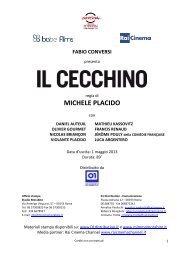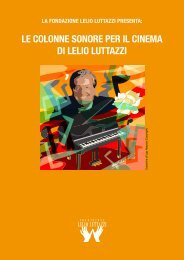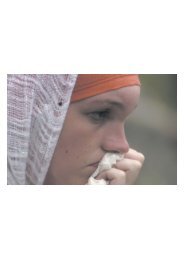Die Stille vor Bach - Studio Morabito
Die Stille vor Bach - Studio Morabito
Die Stille vor Bach - Studio Morabito
You also want an ePaper? Increase the reach of your titles
YUMPU automatically turns print PDFs into web optimized ePapers that Google loves.
“The other continuity of Pere Portabella"<br />
Text by Josep Torrell<br />
In his films, Portabella has broken into pieces the rules of narrative continuity of the<br />
model of institutional representation. The model of intention of Portabella has almost<br />
always been to investigate the relations of the change of shots: what happens<br />
between a shot and the following one; and, by extension, the phenomena that take<br />
place between the passage from a sequence to another one. On this invisible space<br />
the radical invention of Portabella unfolds. Thus, he has annulled the hierarchical<br />
structuring of sequences in fa<strong>vor</strong> of a more kaleidoscopic structure, where every<br />
sequence is independent on its own. He has taken away the meaning of the distinction<br />
between preparatory sequences and culminating sequences, sweeping away any<br />
hints of transitional sequences. The dramatic progression has been replaced by a<br />
structure in which the aesthetic criteria weigh more than the narrative ones.<br />
But his blind rage about the narrative transparency has also originated the investigation<br />
of, what we could call, the ways of another narrative continuity. That is to say, the<br />
footpaths of a continuity of a new breed, freer and without any bounds. In other words:<br />
what Straub and Huillet were looking for during many years is what Portabella had<br />
found in the Barakaldo steel mills in the shooting of General Report: a shooting that on<br />
its own time limits reveals all the critical intention by which it was shot. Or the scene<br />
between Jeanine Mestre and Christopher Lee in Umbracle, for example, proves that<br />
the consistency of a slowed down tempo also works inside the scene, and not only from<br />
the sequence. Or the sequence in The Silence before <strong>Bach</strong> about the combat<br />
between the Pianola and the camera, shows a way of shooting which is absolutely<br />
visual, clearly innovating and eminently aesthetic. The remission to Eisenstein in<br />
Nocturno 29 is also the best known amongst the film directors of the Soviet editing<br />
school, that is to say, to most combative of the ways of alternative representation that<br />
included the possibility of a different way of representing ideas.<br />
The search carried out by Portabella during forty years has its own internal rationale -<br />
the scaffolding structure, in his own words – related to a narrative continuity different<br />
from the conventional one (the continuity by the discontinuity). The change of a take -<br />
or of a sequence it is the central matter of the cinematographic narrative, and it is here<br />
where Portabella has located good part of his power.<br />
All the discourse about surprise is, at the same time, a reflection on continuity. It is<br />
because of this centrality that his cinema does not age, it rather looks growingly<br />
present. Because while cinema exists, those who create it will have to face the<br />
14


